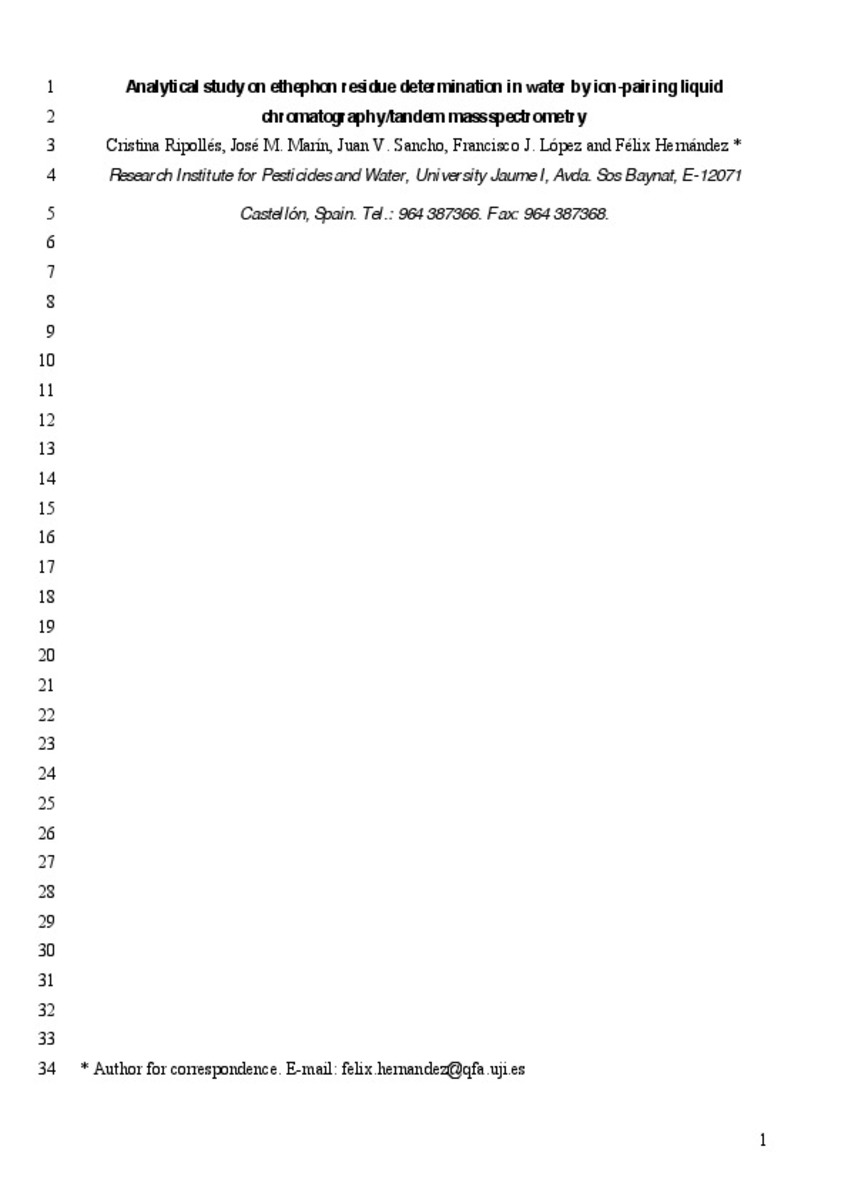Mostrar el registro sencillo del ítem
Analytical study on ethephon residue determination in water by ion-pairing liquid chromatography/tandem mass spectrometry
| dc.contributor.author | Ripollés Vidal, Cristina | |
| dc.contributor.author | Marín Ramos, José Manuel | |
| dc.contributor.author | Sancho, Juan V | |
| dc.contributor.author | Lopez, Francisco | |
| dc.contributor.author | Hernandez, Felix | |
| dc.date.accessioned | 2012-05-30T06:50:05Z | |
| dc.date.available | 2012-05-30T06:50:05Z | |
| dc.date.issued | 2011-11-22 | |
| dc.identifier.citation | International Journal of Environmental Analytical Chemistry (2011) vol. 91, no. 14, pp. 1380-1391 | ca_CA |
| dc.identifier.issn | 0306-7319 | |
| dc.identifier.issn | 1029-0397 | |
| dc.identifier.uri | http://hdl.handle.net/10234/39220 | |
| dc.description.abstract | A detailed analytical study on ethephon residue determination in water, making use of ion-pairing liquid chromatography coupled to electrospray tandem mass spectrometry (LC/MS/MS), has been carried out. Ethephon is a plant growth regulator, highly polar, which is typically present in aqueous solution in anionic form due to its acid character. Both its extraction and pre-concentration from water samples and its chromatographic retention are difficult. Several approaches for sample pretreatment have been tested including direct injection into the chromatographic system, on-line solid phase extraction (SPE) and off-line SPE, with the best results being obtained after off-line SPE, using Oasis MAX cartridges (mixed-mode strong anion-exchange). After testing several ion-pairing reagents, tetrabuthylammonium acetate (TBA) was selected. This was added to the samples before LC/MS/MS analysis to facilitate ethephon chromatographic retention. The acquisition of several specific MS/MS transitions together with the evaluation of their relative intensity ratios allowed the reliable confirmation of the analyte in samples. The optimised approach was tested in low-salinity water spiked at 0.1 µg L−1 level with satisfactory recovery, and a limit of detection of 0.02 µg L−1. To this purpose, the water sample was partially de-ionised in an initial stage, in order to remove major ions that would have interfered in analyses. The application of this methodology to more saline/complex water samples, as surface or wastewater, was problematic and a thorough optimisation of the de-ionisation conditions would be required. | ca_CA |
| dc.format.extent | 19 p. | ca_CA |
| dc.format.mimetype | application/pdf | ca_CA |
| dc.language.iso | eng | ca_CA |
| dc.publisher | Taylor & Francis | ca_CA |
| dc.relation.isFormatOf | Versió pre-print del document publicat a: http://www.tandfonline.com/doi/abs/10.1080/03067319.2010.520131 | ca_CA |
| dc.rights | © Taylor & Francis | ca_CA |
| dc.rights.uri | http://rightsstatements.org/vocab/InC/1.0/ | * |
| dc.subject | Ethephon | ca_CA |
| dc.subject | Ion-pairing liquid chromatography | ca_CA |
| dc.subject | Tandem mass spectrometry | ca_CA |
| dc.subject | Tetrabuthylammonium | ca_CA |
| dc.subject | Water analysis | ca_CA |
| dc.subject.lcsh | Liquid chromatography | ca_CA |
| dc.subject.lcsh | Mass spectrometry | ca_CA |
| dc.subject.other | Cromatografia de líquids | ca_CA |
| dc.subject.other | Espectrometria de masses | ca_CA |
| dc.title | Analytical study on ethephon residue determination in water by ion-pairing liquid chromatography/tandem mass spectrometry | ca_CA |
| dc.type | info:eu-repo/semantics/article | ca_CA |
| dc.identifier.doi | http://dx.doi.org/10.1080/03067319.2010.520131 | |
| dc.rights.accessRights | info:eu-repo/semantics/openAccess | ca_CA |
| dc.type.version | info:eu-repo/semantics/submittedVersion |
Ficheros en el ítem
Este ítem aparece en la(s) siguiente(s) colección(ones)
-
IUPA_Articles [307]







